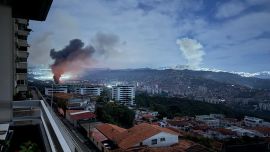You might say it started when Gabriel Moscovici made a proposition to his students in the Villa 21-24 shantytown in Barracas that they should work on a story about the neighbourhood’s imminent centennial anniversary.
You might say the true starting point for all this was, in fact, the famous ‘gol olímpico’ (a goal scored direct from a corner) that Argentine Cesáreo Onzari converted 100 years ago during a friendly match between Argentina and Uruguay.
Or you might also consider that last week’s celebration was the result of the will of some crazy individuals who convinced themselves that it was the perfect moment to organise a community festival, a neighbourhood celebration merging history, football, music, food and identity.
“We understood that it was time to transcend our role as educators and capitalise the territorial strength constructed by different players in the neighbourhood to generate a space for a community gathering around a symbolically very powerful event,” Moscovici told Perfil last week.
That symbolically very powerful event? Onzari’s goal, of course. The first “Olympic goal” in history. That impossible goal which, on October 2 earlier this month, took place a century ago.
What happened at the Sportivo Barracas stadium that day had an impact on football as well as language. Uruguay, the recently crowned Olympic football champions at the 1924 Paris Games, had organised two friendly matches against Argentina. The first took place in Buenos Aires, at the 37-000-capacity venue in the south of Buenos Aires.
The presence of the Olympic champions drew attention and created three definitions used to this day: before the match, the authorities put some wiring around the pitch to prevent the invasion by supporters – “alambrado olímpico,” or “Olympic wiring”; Uruguay’s players also walked the perimeter to greet the fans in the stands: a “vuelta olímpica,” or “Olympic lap”; And finally Onzari, a deft right winger who played for Huracán, converted a goal straight from the corner kick: a “gol olímpico,” or ”Olympic goal.”
The combo deserved a celebration. And it happened last weekend just off Avenida Iriarte, close to where, until 1942, one of the goals of the Sportivo Barracas stadium once stood.
Driven by three organisations – Antropolúdica, Cooperativa ArqueoTerra and Pintando mi Aldea – a festival of music and theatre shows, games for kids, craft activities and food celebrated the local community. Entrepreneurs from the neighbourhood were present too, with an exhibit of old cars and murals.
But, above all, there was a dig, an excavation of a very historic site.
Guadalupe Vázquez lives in a house on Calle Río Limay. According to calculations by archaeologists, towards the back of her house is a spot where one of the corners of the pitch within the Sportivo Barracas stadium once stood.
It is the exact one from where Onzari scored his famous goal, but the opposite one. It does not matter: they had to dig anyway. Specialists with a pick and a shovel excavated, seeking to reach those layers of ground where the finest footballers in the world at that time once stood.
“We have lived with my family in this neighbourhood for 12 years,” said Vázquez. “Little by little, we increase what we understand as neighbourhood identity, starting from the link with people and institutions making up the Barracas landscape.”
Guadalupe said she did not hesitate to open the doors of her house when she was approached. “The atmosphere and the history of the neighbourhood represent us,” she said.
The festival, celebrating that famous goal, went on all day, and quite a bit of the night too. There were music performances, tango, a restaged victory lap and a short film telling the history of the famous goal, featuring a special commentary made for the event by Víctor Hugo Morales, with analysis by Alejandro Apo.
In this corner of Barracas, delineated by the streets Perdriel, Río Cuarto, Luzuriaga and Iriarte, where one day Carlos Gardel sang, there was once nothing to remember that famous moment 100 years ago. Until last weekend, when with the “Festi Gol Olímpico,” a neighbourhood became a little bit more aware of its own history.



















Comments